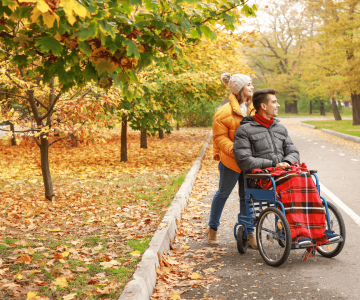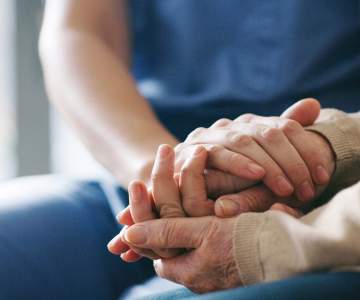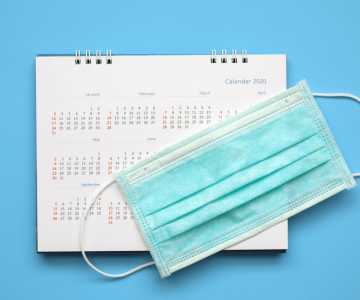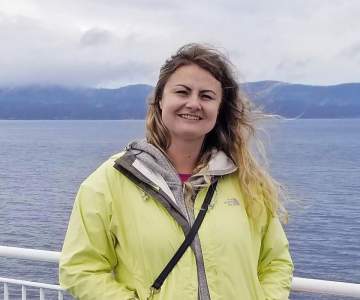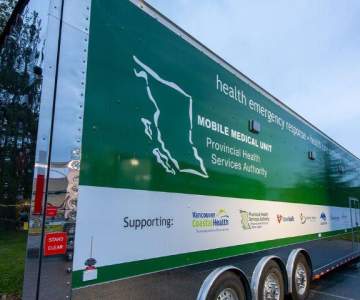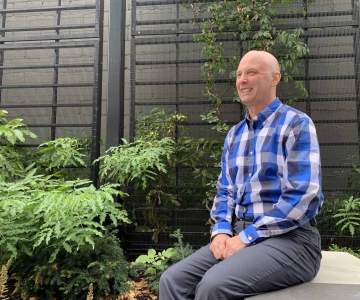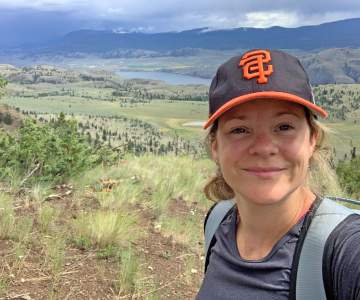Breadcrumb
Explore Stories
2 Minute Read
Health & Wellness
Autumn is the season to enjoy the leaves turning gold and crimson, the farmers harvesting their apple orchards, and families and loved ones feasting at Thanksgiving. Let's make the most of these activities and more by keeping ourselves safe from spread of COVID-19 in our communities.
We know what to do - it's back to the basics.
Here are eight layers of protection that we can incorporate to stop the spread of COVID-19 in our neighbourhoods, schools, workplaces and communities:
Have a plan to stay home when someone in your family is feeling unwell. Feeling sick? Stay home. Plan ahead with those in your household what you will do if someone is unwell. Be prepared for those days when you can stop the spread by staying in. When experiencing symptoms of COVID-19, get tested.Fewer faces in bigger spaces – keep your groups small. As we head into the colder weather, we’ll be indoors more. It’s more important than ever to keep close gatherings to the same small group of people.Keep your distance: Stop the spread by making space for yourself and others. Whether you’re at the store, at work or near others outside of your bubble, maintain a safe physical distance of two metres.Use masks when you can’t keep your distance: Keep masks on hand for your family when inside in public spaces, and in close contact with others.Pass on the shared meals: Avoid sharing food and drinks, including homemade foods like birthday treats or bake sale items. Students should label all their personal items and not share them.Wash your hands – especially during cold and flu season: As basic as it seems, this is one of the most effective ways to stay healthy and limit the spread of illness. Use soap and water, and do it often.Take time to talk: It’s ok to have questions and to share concerns or thoughts with your family and friends. Let’s encourage each other to talk about our plans, strategies and ways of staying safe this fall and winter.
2 Minute Read
Community & Culture
In modern society, we often undervalue the process of becoming older and instead focus on the end, of ‘being old’. The reservoir of knowledge that comes with time is one of the many values of aging.
There are many misconceptions and stigmas about aging. Unfortunately, these can prevent younger people from understanding the wisdom that comes with getting older.
As there are increasing numbers of older people in our society, new conversations have unfolded about the process of becoming older, including what it feels like and how it shapes the aging experience. These conversations are incredibly important as they demonstrate a person’s lived experience or human heritage, is a form of wisdom.
Cultivating the wisdom of aging requires a commitment to understanding the person and an investment in learning about the knowledge and experience they have acquired. Here are some ways you can learn from or with an older person, in order to cultivate wisdom:
Try unfamiliar things. Each time you try something unfamiliar you are opening yourself to learning or a growth mindset.Face your fears and do the uncomfortable. Look for things that challenge you and find meaningful growth in the experience.Talk to people with different perspectives or life experiences. Listen closely to the hardships, triumphs these will teach you about perspective, kindness and compassion.Pursue education. Purposely choose exposure to organized and well-researched points of view.Read. Use this quiet time to process and reflect on what you have learned.Lead with a beginner’s mind. Keep your mind open and curious.Review cause and effect. Being able to see patterns and linkages requires time for reflection.Slow down. Develop skills in meditation and mindfulness.Interested in learning more about cultivating wisdom? Check out the Change Maker Academy.
These are some of the techniques we explore in our work as gerontologists. Although often misinterpreted as the study of older adults, gerontology is the study of aging.
2 Minute Read
Health & Wellness
The harm experienced by Aboriginal peoples did not stop when the last residential school closed its doors in 1996. The effects of this policy are still felt today and are also inter-generational. Trauma-informed practice is an important tool in providing culturally safe health care to patients and clients who may be experiencing the long term effects of residential schools.
We must all work towards trauma-informed practice and culturally safe care for our patients and clients.
Susan Brown, IH President and CEO
Orange Shirt Day is observed on September 30, a day set aside to remember the harmful legacy of residential schools. This week on the Interior Voices podcast, Aboriginal Mental Wellness Practice Lead Jody Wagner joins hosts Vanessa Mitchell and Kris Murray to discuss Orange Shirt Day and the importance of trauma-informed practice.
Trauma-informed practice recognizes the long term health effects of trauma, seeks to understand where a person is coming from, and creates a safe space for the patient or client.
"Orange Shirt Day is a great example of how to approach trauma from a strengths-based capacity-building place," says Jody. "It can empower people to share and begin to heal from that trauma."
To hear the full conversation and learn more, tune in to the latest episode of Interior Voices.
Tune in to the podcast series
Interior Voices is a podcast that explores the intersection of health and culture in the workplace, everyday lives, and patient care. While it was created to help expand IH staff and physician engagement around cultural safety, many episodes will also interest community members. The series includes interviews with IH staff, physicians, and others living and working in the Interior region.
Learn more …
Check out the resources and concepts discussed in this episode:
One-And-A-Half Men: The Story of Jim Brady and Malcolm Norris
Aboriginal Mental Wellness Plan
Orange Shirt Day website
Truth and Reconciliation Commission
Residential school goes from tragedy to triumph (St. Eugene)
The wisdom of Mary Paul
Behind Closed Doors: Stories from the Kamloops Indian Residential School
Anahim Lake Dormitory (Ulkatcho) Residential School
Missing Children and Unmarked Burials report
United Nations Declaration on the Rights of Indigenous Peoples
Trauma-informed Care Toolkit
E-mail Jody Wagner
3 Minute Read
Health & Wellness
Cardiovascular disease (CVD) is the number one cause of death on the planet. Smoking, diabetes, high blood pressure, obesity, and air pollution can increase your risk for CVD.
But did you know at least 80 per cent of premature deaths from heart disease and stroke can be avoided?
In B.C., we know that 1 in 3 people have a chronic disease, we rely too much on cars instead of our feet, many of us do not have access to healthy foods, and in tobacco use rates are higher in the Interior Health region than elsewhere in the province.
How you can reduce our control your risk of cardiovascular disease
Use your feetSet a goal to walk for an hour a few times a week, or walk or cycle to work, or take the stairs instead of the elevator. Every step helps, and walking regularly is proven to reduce your risk of chronic disease.
Make healthy eating choices Helping out our hearts doesn’t have to mean giving up your favourite foods. Think about adding fruits and vegetables, choosing whole grains more often, and being mindful of your fat choices (choosing unsaturated fats such as olive oil or vegetable oil more often than saturated fats such as butter or coconut oil).
Quit smokingMany people who smoke have already tried to quit. Nicotine is incredibly addictive and can make it very difficult to quit without help. There are proven ways to improve your chances of success in ending the addiction – mainly by combining proven methods, such as Nicotine Replacement Therapy, medications and counselling. The health effects of quitting can be felt in as little as 20 minutes from that last cigarette! Within one year of being smoke-free, the risk of coronary heart disease drops by half, and continues to drop until eventually you have the same risk as a non-smoker.
Support health policies in your communityWe all live in communities that are shaped by policies. These policies can help us make healthier choices. For example, they can ensure streets and trails are safe and accessible for all ages and abilities, or increase the capacity of local food systems, or create equitable access to affordable healthy food. Our community plays a big role in our ability to adopt healthy habits and stick with them. Many local governments have passed smoke-free bylaws to reduce the risks of second hand smoke and reduce the likelihood the next generation will see smoking as socially acceptable.
Healthier communities lead to healthier hearts
A healthy community is when the built, social, economic, and natural environments provide people the opportunity to live to their full potential and to come together to make their community better for themselves, their family, friends, and neighbours.
Remember, big change starts with small steps. September 29th is World Heart Day
4 Minute Read
Research & Innovation
The past seven months reflect some of most turbulent times our country has seen, so if you are feeling anxious and confused, I understand.
The COVID-19 picture today is much clearer than it was when B.C. declared its first case on Jan. 28, 2020. That solid plan we all craved then has come into place and we are entering the next phase of the pandemic armed with increased knowledge and medical expertise about COVID-19.
It is nothing short of remarkable to look back to Feb. 14 when Interior Health recorded its first case of COVID-19. Our area of the province acted, we sacrificed, we kept our hospital admissions low, and our case counts down.
We have, tragically, had two deaths in the Interior Health region from COVID-19 and we know that no matter how low our numbers the impact is significant, especially for families who have lost loved ones. These losses are reason enough for all of us to continue to follow the safety precautions every day.
Our public health teams have dealt with a diverse range of COVID-19 cases and outbreaks since March.
We managed B.C.’s first outbreak of COVID-19 in a group of temporary foreign workers at an agricultural business. Later, illness at a South Okanagan farm was another example of excellent work as the spread was contained to the farm itself with only four people testing positive.
The same infection control measures and contact tracing went into high gear when outbreaks were declared at two long-term care sites. Swift action and teamwork resulted in only one person testing positive at each site and no residents becoming ill.
Similarly, outbreaks at the Okanagan Correctional Centre were kept to low numbers. In the second outbreak, declared over on Sept. 10, no inmates became ill.
Our contact tracers have worked tirelessly to reach anyone exposed to the almost 500 people in the Interior who have tested positive for COVID-19 since February. The efforts of our medical health officers, epidemiologists, environmental health, communicable disease and public health staff – all working together – are how we were able to bend the curve back in Kelowna after the July long weekend when a cluster of cases grew from a series of parties.
As CEO, I am proud of our teams, including the staff and physicians at COVID-19 testing sites, in hospitals, in the community, in long-term care, housekeeping, and assisted living facilities, in our labs, in our pharmacies and behind the scenes across all departments.
But – our success to date is not something health-care workers can do alone: we need you. In fact, we are counting on you to continue with the valiant efforts you have all shown to date.
None of the achievements listed above would have been possible without the outstanding commitment from the people who live in the Interior Health region. You stepped up. You washed your hands vigorously, you stayed close to home when you were asked not to travel, you are staying home now when feel ill, and you have maintained appropriate physical distance from others and have chosen to wear masks as an added precaution. These measures must continue in the months ahead.
Now, we’re re-starting our fall routines, including back-to-school.
We are watching this important and necessary step carefully. Our public health teams are ready to jump into action to support the school community and our children. Our medical health officers are working with school districts to answer questions from families and students and ease their fears.
While COVID-19 is new, dealing with communicable diseases such as meningitis and measles in schools is not. This is the role of public health and something we do very well.
We are also prepared at our testing facilities and have strengthened our IH lab capacity. More people have been trained and we’re ready to ramp up testing if required.
In some communities test results took longer than I wanted to see, so over the summer we focused our efforts on training more lab staff and stocking supplies to streamline testing. Today when you look at the B.C. Centre for Disease Control data page, Interior Health test results are typically a day or less.
As we head into the fall, we are urging everyone to keep their bubbles small. The precautions that help protect our long term care homes can be applied to schools. Together, fewer contacts and smaller bubbles will help prevent the spread of COVID-19 and its introduction to schools.
Our public health teams are equipped to follow up on COVID-19 cases, our primary care and hospital staff and physicians have the latest information on how to treat the illness, but none of us can stop the transmission of the disease alone. We need you.
I appeal to you to not be complacent and to continue to follow the safety precautions that we know works in stopping communicable diseases, including COVID-19. Stay home when you’re sick, maintain physical distancing, wash your hands frequently and keep your bubbles small.
We can do this together. Let’s renew and refocus our efforts to control this virus, to protect ourselves and loved ones from COVID-19.
2 Minute Read
Community & Culture
We Are IH is a new recognition campaign to spotlight our people in a real way – through pictures and stories that allow their authenticity to shine through! Each month, four Interior Health employees or medical staff will be featured through our News@IH website and our weekly In the Loop Roundup email newsletter.
With a love of connecting with others, Nicole chose a career at Interior Health where her presence creates a positive impact on the lives of people in her community. Over the past 2.5 years as the Assistant of Organizational Development & Change/Learning Management Systems at Community Health & Services Centre, Nicole has continued to be inspired by building relationships with her peers and customers.
As an avid learner of new skills, Nicole brings so much value to her team as she collaborates with her peers to bring positive change to IH. Her hard work was showcased as she handed over $1,000 to the Okanagan Boys and Girls Club for Pink Shirt Day that she led on behalf of IH. It’s moments like this that make Nicole’s favourite quote, “never take anything or anyone for granted”, even more relevant.
Born and raised in Kelowna, Okanagan / Syilx (Saay-ilks) Interior Salish, she loves exploring the beautiful four-season playground of the Okanagan. Luckily the golf season is the longest in the country because Nicole loves golfing and the thrill of making a good shot. With a passion for cooking and entertaining, she loves hosting her family and friends over a delicious meal.
You may not know this about Nicole, but she loves singing, even if it is mostly for herself. Wanderlust at heart, she is patiently waiting for the time when she can travel again and experience new places. Thank you Nicole for all that you do for your community and Interior Health!
Check back each Friday for the next We Are IH feature.
For more information contact EmployeeExperience@InteriorHealth.ca.
Nicole's nomination of Tealya Vickers keeps the We Are IH loop going:
Tealya will always be there for support, advice, or passing on her extensive knowledge to her team. She is always positive and eager to help and learn. She is a wonderful example of a dedicated IH employee!
3 Minute Read
Health & Wellness
The Mobile Medical Unit is rolling towards home after a successful deployment at Cariboo Memorial Hospital (CMH) in Williams Lake.
With the hospital needing to undergo significant renovations as a result of a pipe bursting in -30C weather in February, the MMU team was able to support CMH while also juggling COVID-19 related deployments like the alternate care site at Vancouver Convention Centre and an outbreak at Abbotsford Hospital.
The six-week time period provided plenty of opportunity to get to know the Williams Lake community, and for the community and local care team members to learn more about the MMU.
"Everyone was aware of it (MMU) being here in the community," says Rebecca Egilson, IHA Local Project Manager of Specialized Community Services Program who worked closely with the MMU team to integrate them with the local care team.
"There was a lot of talk about it as it’s been highly visible and, anything as high profile as the MMU gets people talking about it."
It’s a bird, it’s a plane, it’s an ICU
One of the topics that got the MMU team themselves talking, was the need to turn the always-flexible facility into a three-bed extension of the CMH Intensive Care Unit (ICU). While the MMU has been deployed to more than 60 sites across the province
Inside the Mobile Medical Unit
and supported everything from primary care, education and renovation support, operating as an ICU had only occurred once before and the team knew they’d need to plan accordingly.
"This was a unique deployment," says MMU clinical operations director Peter Hennecke. "We did an ICU deployment in Cranbrook in 2012, but this was much longer. As well, this was our first deployment installing a computerized pharmaceutical dispenser within the unit."
"One of the successes of this trip for us was how we continue to learn more about quickly integrating the MMU’s systems and equipment with an established team’s workflow and processes," says Peter. "Every time we do something a little different like this, we learn more about our abilities and our equipment."
While the MMU can accommodate any level of patient acuity, the potential needs of an ICU patient required specific preparation. This flexibility and attention to detail impressed Rebecca, as did the team’s ability to work so closely, so quickly, with Interior Health clinical staff.
"The MMU team threw themselves into getting us up and running very quickly," says Rebecca. "They helped us do everything from setting up the beds to moving supplies and prepping an additional crash cart. Because of this, we were able to get started on the renovations sooner than expected and even get finished earlier than expected."
Specialized training a bonus
As well as serving as an extension of CMH’s ICU, the MMU team are also going to be conducting specialized training for about 25 of the hospital care team prior to leaving town. Several MMU team members have some very unique career experiences that make them highly qualified for disaster management training, including time spent in the military as well as on United Nations missions abroad.
"We’re very grateful for their training expertise, especially because they’ve already done the course development work," says Rebecca.
Learn more about the MMU by visiting bcmmu.ca or following the program on twitter @MobileMedicalBC.
This story was originally published by the B.C. Provincial Health Services Authority.
1 Minute Read
Health & Wellness
Working as an environmental health officer (also known as a public health inspector), you never know what the day might bring.
You might find yourself inspecting drinking water systems, restaurants, public swimming pools, or tanning salons. We also investigate public health complaints, disease outbreaks, industrial camps, and special events.
Environmental health officers respond to public health emergencies such as wildfires, floods and landslides, by providing health information about air quality, drinking water quality and food safety.
And when we’re not doing those things, we work on health education, such as helping to inform the public about indoor and outdoor air quality.
One area we are particularly passionate about is improving the health of our communities. We work with municipalities and aboriginal leaders to provide information about health equity, tobacco reduction, healthy built environments, and emergency preparedness. These topics are essential to improving population health outcomes and reducing disease.
We understand that regulating and monitoring certain aspects of the environment that have a direct impact on public health helps to keep us all safe from health hazards and protects our families, friends, and neighbours.
Interested in exploring career options at Interior Health? Check out jobs.interiorhealth.ca.
2 Minute Read
Community & Culture
We Are IH is a new recognition campaign to spotlight our people in a real way – through pictures and stories that allow their authenticity to shine through! Each month, four Interior Health employees or medical staff will be featured through our News@IH website and our weekly In the Loop Roundup email newsletter.
Motivated by her desire to help, Carla chose a career that she knew could create impactful change in the lives of others. As a Social Worker for over 10 years, Royal Inland Hospital has been lucky to have Carla as part of the team for the past six years, primarily in Kidney Care Clinic and Transplant programs.
Carla’s role has expanded as an active member of many committees: National Conservative Care, Management Committee, BC Pre-Emptive Transplant Committee, and Polycystic Kidney Disease Committee. The proudest moment in her career was being invited as a member of the Ethics Committee. Congrats Carla, well deserved! In addition, she has been trained as a facilitator for the Serious Illness Conversation, and at her local hospital, she has developed and taken the lead for the Palliative Response Team during COVID-19 and is a member of the Morgue Process Committee and Ethics Committee.
Born and raised in Kamloops / Secwépemc (She-whep-m), Carla has always been inspired by people in her life, photography, and art. To this day, her favourite hobby outside of work is capturing images with her camera and creating art. As an avid learner, Carla is always educating herself and providing insight and learning resourceful ways to make a change.
Her love of caring for people extended past her career as a Social Worker as she took on the role of a volunteer firefighter to serve and protect her community. As motivated as Carla is, she also knows how to work hard and play hard. She enjoys looking forward to the weekend spending quality time with loved ones and creating art.
Check back each Friday for the next We Are IH feature.
For more information contact EmployeeExperience@InteriorHealth.ca.
Carla's nomination of Annelise Beach & Jenni Culbert keeps the We Are IH loop going:
Annelise Beach is always helping out where she can, eager to learn, and a strong member of the Social Work team.
Jenni Culbert is the fearless leader of Social Work who encourages the development and personal growth of each member of the Social Work team.
-
Load More
Showing 612 of 679
STAY CONNECTED
Receive news and alert posts, and Stories@IH blog posts, right to your inbox!

